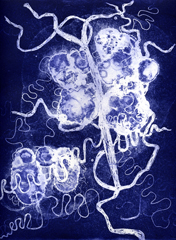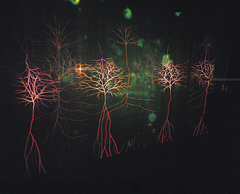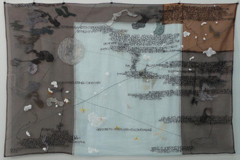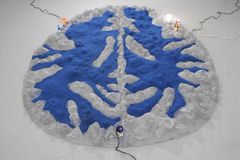|
|
ARTISTS
Landscapes of the Mind features the work of four contemporary artists—Susan Aldworth, Andrew Carnie, Jessica Rankin, and Katy Schimert—who blend the worlds of art and science. Their work visualizes the internal processes of the brain such as memory, thought, and perception using images drawn from or inspired by the brain. In a variety of media including etchings, embroideries on organdy, installation, and sculpture, these artists explore identity, creativity, personality, and the nature of consciousness.

Brainscape 18, 2006; collection
of the artist.
|
SUSAN ALDWORTH (British, b. 1955)
Susan Aldworth became interested in the brain as a visual image after she was a neurology patient. Her work addresses questions of defining personality and whether it can be physically located. In her series of etchings called Brainscapes (2006) and their corresponding location drawings, each piece is based on her observations of patients’ cerebral angiograms at the Royal London Hospital. These works allow her to explore consciousness and the sense of self within the physical brain. |

Magic Forest, 2002; collection of the artist. |
ANDREW CARNIE (British, b. 1957)
Andrew Carnie has created a work entitled Magic Forest (2002) that demonstrates the birth and differentiation of brain cells (neurons) in a beautiful and stunning manner. In a darkened room, two slide projectors project images of increasingly complex and numerous neurons onto large hanging diaphanous screens that viewers can walk between as if they are inside a brain cavern. |

Flat Land, 2008; courtesy of the artist, White Cube, London and Carlier/Gebrauer, Berlin.
|
JESSICA RANKIN (Australian, b. 1971)
Jessica Rankin uses the medium of embroidery for her large organdy pieces which are pinned to the wall. A medium often used by previous generations of women in their handiwork, Rankin employs her embroidery to create complex layers of text, image, and color. Rankin makes the 'exterior' processes—or what the brain produces—visible, i.e. consciousness, language, dreams, and memory. Her newest work, shown for the first time in the exhibition, is based on images of neurons.
|

A Woman's Brain, 1995; Williams College Museum of Art.
Gift ofPatricia and Frank Kolodny.
|
KATY SCHIMERT (American, b. 1963)
Katy Schimert is interested in how the internal body mimics the external world. Using simple domestic materials (wire mesh, felt, and lightbulbs), Schimert’s floor piece, Brain, was inspired by her interest in the differences between the male and female brain. Schimert recreated her Oedipal Blind Spot wall drawing for the exhibition that
concurrently explores the visual system, the story of Oedipus, and Freudian symbolism. This work has previously been exhibited at Tate Modern, the Whitney Museum of American Art, the University of California Berkeley Art Museum, and the Renaissance Society at the The University of Chicago. Untitled (2006) contemplates the head as a container for the brain. |
|
|






